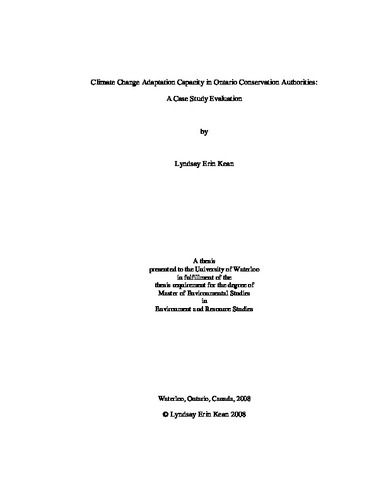| dc.description.abstract | In Canada, anticipated climate changes including an increased frequency of hot temperature extremes and intense precipitation events, are projected to affect surface water and groundwater resources with respect to water quality and water quantity. At the watershed scale, examples of these effects include changes to water flows and water availability, runoff and evaporation patterns, and dissolved oxygen and phosphorus concentrations, with potentially negative implications. In Ontario, Conservation Authorities (CAs) play an important role in managing and protecting water resources at the watershed scale, through collaboration with the municipal and provincial governments, stakeholders and community members. The projected effects of climate change on water resources will be felt at the watershed scale and will have an impact on existing activities within CAs. Research suggests that current management practices may not be sufficient to adapt to climate change effects. Therefore, CAs should be involved in climate change adaptation. This research evaluated what capacity Ontario CAs currently have for climate change adaptation, through a case-study comparison of two CAs – the North Bay-Mattawa Conservation Authority (NBMCA) and Credit Valley Conservation (CVC). An evaluative framework with indicators of capacity in three environments – the institutional environment (i.e., presence and quality of institutional arrangements), the organizational environment (i.e., organizational resources and organizational dynamics) and the action environment (i.e., community and political support), was developed through a literature review. The evaluative framework was used to assess CA capacity for climate change adaptation through information obtained from open-ended, semi-structured key informant interviews with CA employees, a review of documentation and direct observation. The results of the evaluation revealed that the capacity for climate change adaptation varied considerably between the NBMCA and CVC, particularly in the organizational environment. CVC had strong capacity in terms of resources availability and had already begun to adapt to climate change in its watershed management activities. The NBMCA was challenged with respect to resources availability and had not yet begun to adapt to climate change. Overall, this research highlighted the importance of developing partnerships, communicating, and sharing resources and expertise with other organizations and the local community. | en |

